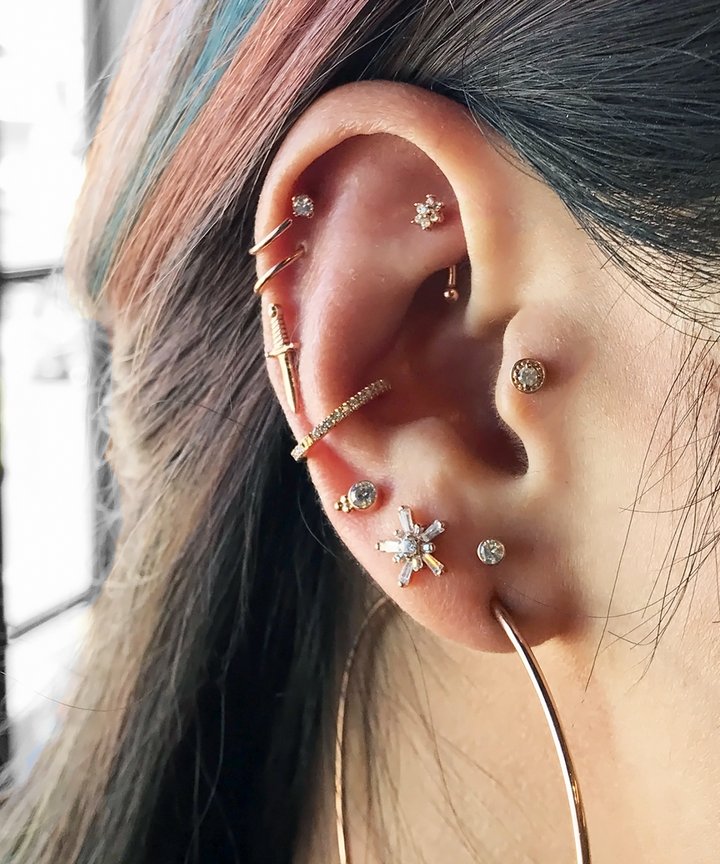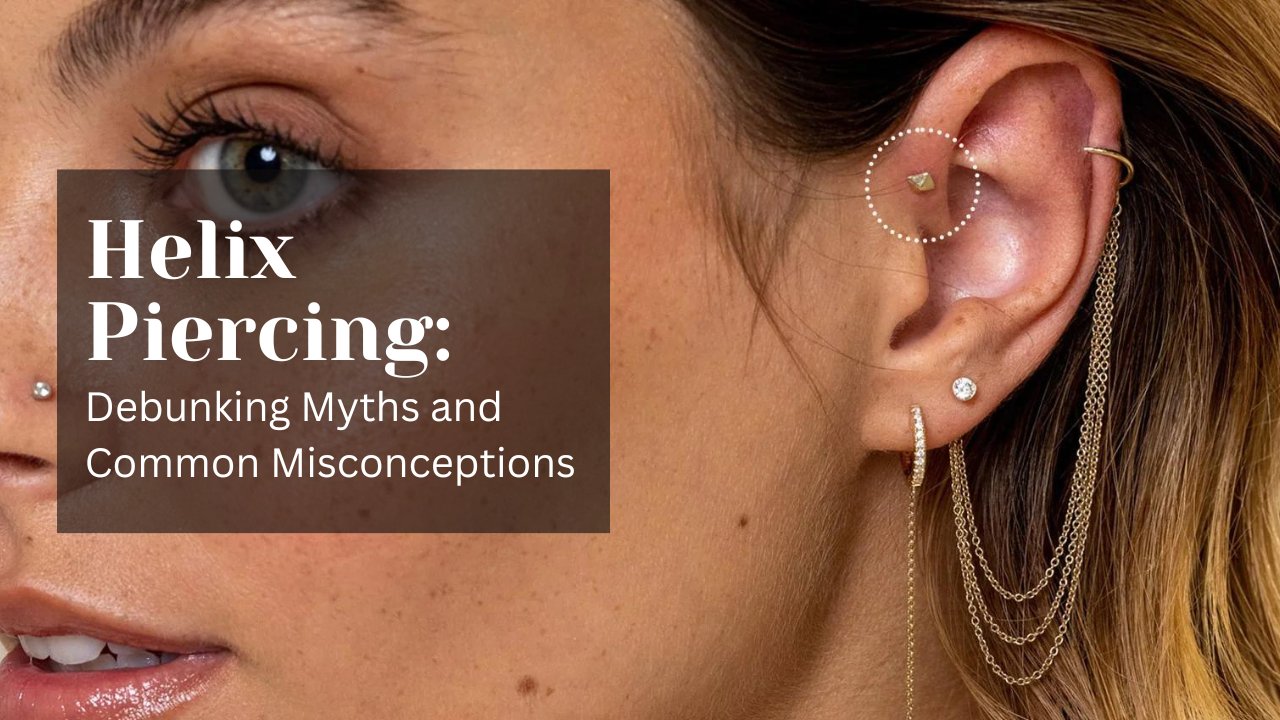Helix piercing is a type of ear piercing that involves piercing the upper cartilage of the ear, specifically the outer edge known as the helix. It is a popular and stylish choice for individuals who want to adorn their ears with jewelry. The helix area provides various options for placement and allows for creativity in ornament selection.
The piercing procedure involves using a sterilized needle to make a small hole in the helix cartilage. Jewelry commonly used for helix piercings includes studs, hoops, and various ornamental earrings specifically designed for cartilage piercings. These pieces can range from simple and minimal to more complex and decorative designs.
The recovery time for a helix piercing can vary, but it usually takes several months to a year for the piercing to heal completely. During the healing process, proper care, including regular cleaning and avoiding trauma or irritation, is essential to ensure optimal healing and minimize complications.
Helix piercings provide individuals with the opportunity to express their personal style through unique jewelry choices and placement variations. It is important to have your piercing done by a professional piercer to ensure proper technique and reduce the risk of complications. As with any piercing, if you experience any concerning symptoms or have any questions, consult a piercer or healthcare professional for guidance.
Myth #1: Helix Piercing Is Extremely Painful
Helix piercing is thought to be a painful treatment relatively frequently and widely. This opinion could come from a number of things, such as personal experience, anecdotes from others, or false beliefs about the piercing procedure. But it’s crucial to understand that everyone experiences pain differently and that it might be subjective.
While some people could feel some minor discomfort or pain while getting their body pierced, it’s crucial to realize that everyone’s tolerance for pain, the piercer’s technique, and the precise site of the piercing all affect how much pain they suffer. could vary.
Many people who have had a helix piercing report that the pain is relatively brief and manageable. Similar to other types of needle-based procedures, the sensation is often described as a quick pinch or pressure. For most people, the anticipation of pain can be more worrying than the actual piercing itself.
It is important to choose a skilled and experienced piercer who follows proper sterilization and piercing techniques. A professional piercer can help ensure that the procedure is performed quickly and accurately, minimizing discomfort and reducing the risk of complications.
It is important to remember that the discomfort felt during the piercing only lasts a brief period of time. As part of the normal healing process, the area may experience discomfort or tenderness for a while after this. Yet during the healing process, which could last several months, this soreness normally progressively goes away.
It is advised that you speak with a qualified piercer if you have any pain-related concerns so they can offer individualized advice based on their experience and help you with any particular issues you may be having.


Myth #2: Helix Piercing Takes Forever to Heal
It is a common misconception that helix piercings have an exceptionally long healing time. While the healing process of a helix piercing may take longer than that of an earlobe piercing due to the thicker cartilage, it is important to note that individual healing times can vary.
On average, a helix piercing takes about 6 to 12 months to heal completely. During this time, the body works to repair tissues and establish a stable channel for the jewelry. However, it’s important to remember that healing time can be affected by factors such as individual healing abilities, aftercare practices, and overall health.
Factors that affect the healing time of a helix piercing include:
- Type of Jewelry: The initial jewelry used for a helix piercing should be high quality, hypoallergenic, and suitable for healing. Jewelry made of materials such as surgical-grade stainless steel, titanium, or gold is generally recommended. Using appropriate jewelry can aid the healing process and reduce complications.
- Aftercare Methods: Consistent and proper aftercare is important for any piercing to heal. Following the care instructions provided by your piercer, which usually include regular cleaning with saline or mild soap, avoiding irritants, and not changing jewelry prematurely, can help promote optimal healing.
- Own Healing Potential: Everybody’s body heals at a different rate. How quickly a helix piercing heals can depend on a variety of factors, including genetics, general health, and immune system performance. It’s crucial to have patience and give your body time to heal.
Although helix piercings take longer to heal than earlobe piercings do, it is still important to use the right aftercare techniques and have patience while they do. A piercing can heal more quickly and with fewer issues if it is not subjected to unnecessary trauma or discomfort.
See a qualified piercer or medical practitioner for advice and appropriate care if you have concerns about the healing of your helix piercing or observe any indications of infection or other issues.

Myth #3: Helix Piercing Always Causes Infections
It is a common misconception that helix piercings are inherently more prone to infection than other types of piercings. While any piercing, including helix piercings, carries a risk of infection, with proper care and hygiene practices, the chance of infection can be reduced.
Misunderstanding can arise from several factors:
- Healing time: Helix piercings usually take longer to heal than earlobe piercings because of the cartilage involved. During the healing process, the piercing site is more susceptible to infection. However, with proper care, infection can be avoided.
- Poor care: Neglecting proper care practices, such as not regularly cleaning the piercing or using inappropriate cleaning agents, can increase the risk of infection. It is essential to follow the care instructions given by your piercer and maintain good hygiene during the healing process.
- Jewelry quality: Low-quality or inappropriate jewelry can irritate the piercing and increase the risk of infection. Using high-quality, hypoallergenic jewelry made from materials such as surgical-grade stainless steel, titanium, or gold may reduce the chance of irritation or an adverse reaction.
To reduce the risk of infection from a helix piercing, it is important to:
- Clean the piercing regularly: Follow the aftercare instructions provided by your piercer, which often involves cleaning the piercing with a saline solution or mild soap. Regular cleaning helps remove bacteria and reduce the risk of infection.
- Wash hands before touching: Always make sure your hands are clean before touching the piercing or doing any cleaning or maintenance. This prevents bacteria from entering the piercing site.
- Avoid unnecessary touching: Minimize unnecessary touching of the piercing to reduce the risk of introducing bacteria. Only touch the piercing with clean hands when necessary, such as during cleaning.
- Use appropriate jewelry: Choose high-quality, hypoallergenic jewelry appropriate for the treatment. Avoid using low quality or cheap jewelry that may cause irritation or a reaction.
- Avoid irritants: Protect the piercing from irritants such as hair products, perfumes, and excessive moisture. These substances can increase the risk of infection or irritation.
While infections can occur, they are not limited to helix piercings alone. With proper care, good hygiene and following care guidelines, the risk of infection can be greatly reduced. If you suspect an infection or experience signs of infection such as pain, swelling, redness or increased discharge, consult your piercer or health care professional immediately. They can provide proper treatment and guidance for a healthy healing process.

Myth #4: Helix Piercing Always Leads to Keloids or Scarring
Keloids and excessive scarring are potential concerns for some individuals considering helix piercings. However, it’s important to note that not everyone is prone to developing keloids, and with proper care and attention, the risk of significant scarring can be minimized.
Here are some key points to consider:
- Keloids: Keloids are thick, raised scars that extend beyond the boundaries of the original wound. While keloids can occur in some individuals, it’s important to recognize that not everyone is genetically predisposed to developing keloids. If you have a history of keloid formation, it’s advisable to discuss this with your piercer or a healthcare professional before getting a helix piercing.
- Scar formation: It’s normal to have some degree of scarring with any piercing. However, proper care during the healing process can help minimize the appearance of scars. Following the aftercare instructions provided by your piercer, avoiding unnecessary trauma or irritation, and maintaining good overall health can aid in promoting healthy healing and reducing the risk of excessive scarring.
- Jewelry selection and fit: Choosing appropriate jewelry for your helix piercing is crucial. Poorly fitted or inappropriate jewelry can contribute to irritation and increase the risk of scarring. It’s important to select high-quality jewelry made from materials suitable for healing, such as surgical-grade stainless steel, titanium, or gold. Additionally, ensuring the jewelry is the right size and properly positioned can help minimize friction and trauma to the piercing.
- Proper aftercare: Consistent and proper aftercare is vital for minimizing scarring. This includes cleaning the piercing regularly with a saline solution or mild soap, avoiding excessive touching or twisting, and protecting the piercing from irritants. Following the aftercare instructions provided by your piercer and seeking professional advice if you have any concerns can help ensure optimal healing and reduce the risk of scarring.
While everyone’s healing process is different, taking proactive measures such as proper aftercare and jewelry selection can help minimize the risk of keloid formation and excessive scarring. It’s important to consult with a professional piercer or a healthcare professional if you have a history of keloids or are concerned about scarring to discuss your individual circumstances and receive personalized advice.
Myth #5: Helix Piercing Limits Jewelry Options
It’s a common misconception that a helix piercing limits your options when it comes to jewelry. In fact, helix piercings offer a wide range of jewelry options, allowing for creativity and personal expression.
Here’s why the misconception isn’t accurate:
- Variety of Jewelry: Helix piercings can accommodate a variety of jewelry, including studs, hoops, rings, barbells, and ornamental earrings specifically designed for cartilage piercings. These options come in a variety of sizes, shapes, materials and designs, allowing you to find the perfect piece of jewelery to suit your style and preferences.
- Multiple piercings: If you have multiple helix piercings or combine them with other ear piercings, such as lobe or forward helix piercings, this opens up even more opportunities for unique combinations and curated ear jewelry looks. You can mix and match a variety of jewelry types, sizes, and styles to create personalized and fashionable ear stacks.
- Customization and Creativity: Helix piercings can be placed in a variety of places along the outer edge of the ear, providing flexibility for jewelry placement. You can choose a single helix piercing or create a curated collection of multiple piercings to create a personalized and unique look. This customization allows you to explore different jewelery combinations and styles.
- Diverse Jewelry Designs: The jewelry market offers a wide range of helix-specific jewelry options. You can find jewelry with gemstones, charms, pendants, intricate designs and various decorative elements. From minimalist and delicate pieces to bold and statement-making jewellery, there are options to suit every taste and style.
It is important to consult with a professional piercer when choosing jewelry for your helix piercing. They can provide guidance on the proper sizes, materials, and styles that work well with your specific piercing and anatomy.
Remember, helix piercings don’t restrict your jewelry options. Embrace the versatility and creativity that helix piercings offer, and explore the wide range of options available to find the perfect jewelry that reflects your personal style.
FAQs: Frequently Asked Questions
Q: Is the helix piercing extremely painful?
Answer: While pain tolerance varies, helix piercings are generally described as a moderate level of pain that is brief and manageable.
Q: Does a helix piercing have an exceptionally long healing time?
Answer: It usually takes about 6 to 12 months for a helix piercing to heal completely. While the healing time is longer than for earlobe piercings, proper care can promote optimal healing.
Q: Are helix piercings prone to infection?
Answer: Helix piercing, like any piercing, carries a risk of infection. However, with proper care and hygiene practices, the risk can be minimized.
Q: Will helix piercings always result in keloids or excessive scarring?
Answer: Not everyone is at risk of developing a keloid, and the risk of excessive scarring can be reduced with proper care. Although some tarnishing is normal, it can be minimized with proper care and jewelry selection.
Q: Does helix piercing limit jewelry options?
Answer: No, Helix Piercing offers a wide range of jewelry options including studs, hoops, rings, barbells and ornamental earrings designed specifically for cartilage piercings.
Q: Can I get multiple helix piercings or combine them with other ear piercings?
Answer: Yes, multiple helix piercings can be done, and they can be combined with other ear piercings to create unique combinations and curated ear jewelry looks.
Q: How do I care for a helix piercing to promote proper healing?
Answer: Proper aftercare includes regular cleaning with saline solution or mild soap, avoiding unnecessary touching or trauma, and avoiding irritation of the piercing.
Q: Is it true that helix piercings have a higher risk of complications than other piercings?
Answer: Like any piercing, a helix piercing has a risk of complications, but with proper care and attention the risk can be minimized.
Q: Can I change my jewelry before my helix piercing is completely healed?
Answer: It is generally recommended to wait until the helix piercing has completely healed before changing jewelry to avoid disrupting the healing process.
Q: Can I swim or engage in water activities with the Healing Helix piercing on?
Answer: It is generally advised to avoid exposing the healing helix piercing to water bodies such as swimming pools, hot tubs and natural bodies of water, as they may contain bacteria or chemicals that can cause irritation or infection .

